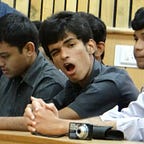The art of dynamic soaring: A lesson from nature
We live in a world that has begun to acknowledge the importance of energy and the steps needed to conserve it. This is an age where we would look towards renewable energy to solve our problems.
And as we search the skies for answers, we see one of the most magnificent of nature’s creations : The wandering albatross.
Albatrosses are among the largest of flying birds, and the great albatrosses (genus Diomedea) have the largest wingspans of any extant birds, reaching up to 12 feet (3.7m).
A bird that big, should find it very hard to fly, shouldn’t it? A simple scaling argument demonstrates that larger birds require much more energy per unit mass to fly. Cruise velocity is proportional to wing loading. Weight increases as the cube of the characteristic dimension, but wing area only increases as the square. Drag forces increase with the velocity squared, so large birds fly faster but suffer a significant power penalty owing to their size. Likewise, the power required to flap large wings for propulsion is much greater than that needed for flapping small wings. Consequently, large birds have learned to soar for extended periods of time without beating their wings.
Now, we need to understand that it’s the airspeed of the albatross that gives its energy. To help you understand this, let’s taking the example of holding a paper plane inside a car. On releasing it, it would fall to the ground. But, if you hold it outside the window, its airspeed increases, it takes kinetic energy from the wind and it flies.
Evolution has made the albatross a genius at calculating airspeed and maneuvering. This bill is composed of several horny plates, and along the sides are the two “tubes”. These tubes allow the albatrosses to measure the exact airspeed in flight; the nostrils are analogous to the pitot tubes in modern aircraft. The albatross needs accurate airspeed measurement in order to perform the dynamic gliding maneuver.
The albatross makes use of the boundary layers of wind over the ocean. Out on the open ocean, the boundary layer, or wind profile, is about 20-m high. A typical windspeed at the top of the profile is 25 km/hr. The albatross conducts repeated zoom maneuvers within the wind profile, constantly exchanging kinetic and potential energy. Here, the albatross constantly loses energy to drag, but periodically regains energy due to vertical motion in the wind gradient. We’ll designate the airspeed as (V), and this is typically about 90 km/hr near the water and 60km/hr at the top of the zoom. First, immediately before and immediately after crossing the wind step, the albatross has the same absolute velocity seen by a stationary observer on the ground. However, the airspeed has suddenly increased by an amount (delta-V) which equates roughly to the change in windspeed (delta-u).
Second, Newton’s law states that the impulse equates to the change of momentum.
Combining and re-arranging these two equations obtains the dynamic soaring thrust.
This vector is aligned with the airspeed. We then deduce from this the dynamic soaring force, a vector which lies in a horizontal plane, pointing directly upwind, and having a value proportional to the mass of the bird and the apparent rate of change of windspeed, “u-dot.” As the albatross maneuvers, this vector of magnitude m du/dt remains steadfastly level and pointed upwind. Components of the dynamic soaring vector will yield thrust, side force, and a slight increase or decrease of lift.
If at any time the albatross were to fly at constant elevation, u-dot would be zero, and as expected, there would be no dynamic soaring force.
During descent in any direction, u-dot is negative. Thus, if the albatross were to descend downwind, the dynamic soaring force vector which points upwind with a negative value would in effect point downwind with a positive value. Thus, the albatross extracts thrust from the wind during both upwind ascent and downwind descent.
To summarize, dynamic soaring involves a climb into the wind, a curve to leeward (downwind), a leeward descent, and a reverse turn close to the sea surface, where the cycle begins anew. The total energy in these maneuvers is the same at the beginning and the end of the trajectory. We also found that the closer the bird got to the water’s surface, the lower the total energy; right near the water, there was no gain at all. The local shear wind lets the bird change the direction of the lift it generates as a kind of propulsive force during the upper curve of the cycle. At that moment, the strong wind acts like a kind of outboard engine. Afterward, the bird dives close to the water and then turns back up, in the process incurring a braking effect. The bird still has a “propulsion profit” over the whole cycle that just manages to overcome drag. As long as it keeps up that pattern of dips, swoops, and turns, it can keep on flying — flying for free.
The mastery of dynamic soaring by the albatross has inspired many scientists like Lord Rayleigh and motivated study in fields like underactuated robotics and passive control.
The open sea isn’t the only place that offers a shear wind field suitable for dynamic soaring, and wandering albatrosses aren’t the only pilots that rely on it to conserve energy. Such boundary layers also exist within the high-altitude jet streams that encircle Earth; even though these layers are much thicker than the one the albatross flies in, the physics are the same. That means that UAVs with the proper aerodynamics and programming might one day exploit them to stay aloft for weeks or months on end, allowing them to serve as surveillance nodes or radio relay links.
